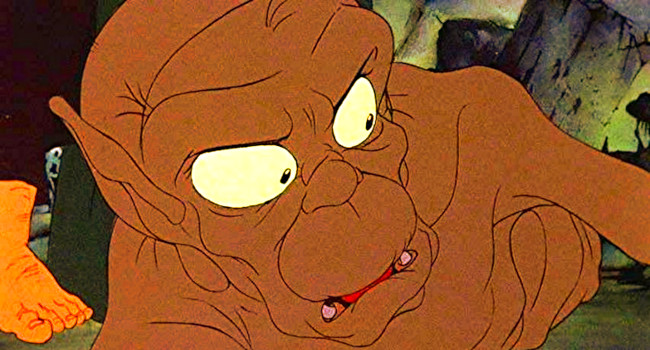1978 was an amazing year for films — especially horror movies. I’m stoked about posting a whole plethora of monstrous missives in October’s lead-up to Halloween. But tonight I’m in the mood for fantasy and I wanted to share this kick ass mash-up I recently added to my YouTube channel.
While you’re likely at least familiar with Peter Jackson’s live action Lord of the Rings trilogy, you might not realize that the first LOTR feature was a masterpiece of strange animation created by cartooning bad boy Ralph Bakshi way back in 1978. It’s worth familiarizing yourself with the latter as many people say it was the blueprint for the former.
The LOTR Wiki comes to the rescue…
Peter Jackson first encountered The Lord of the Rings via Bakshi’s film, and some shots in his live-action trilogy appear to have been influenced by it:
One such shot features Frodo and the other hobbits hiding from a Black Rider under a big tree root, while the Black Rider stalks above them. In his version of the sequence, Jackson uses a similar shot — although he films it from a different angle (in the book, Frodo hid separately from the other hobbits).
A second sequence features the camera slowly revolving around Strider and the hobbits, who stand in a circle as the Black Riders approach them on Weathertop. In his staging, Jackson also uses a similar shot — although his camera is much faster, and Strider is not among the hobbits.
A third similarity is the depiction of Gollum losing the ring in the prologue: both films show very similar events but the book had no such prologue and indeed it runs directly counter to Tolkien’s scheme for the storyline.
Another similarly staged scene is Legolas, Gimli, and Aragorn’s discovery of Gandalf the White.
On the DVD commentary of The Lord of the Rings: The Fellowship of the Ring, Jackson acknowledges one shot, a low angle of a hobbit at Bilbo’s birthday party shouting “Proudfeet!”, as an intentional homage to Bakshi’s film.
By far the biggest “lift,” however, is the scene of the Nazgûl appearing in the hobbits’ room at the Prancing Pony and slashing the beds to ribbons thinking the shapes under the sheets to be the hobbits (but are actually pillows). This is almost identical to Bakshi’s version, which is significant, as the scene is not depicted in the book; a passage does appear that states that hobbit beds wind up slashed during the night, but the townsfolk of Bree are the perpetrators, not the Nazgûl.
Some of Sam’s interjections are also sourced from Bakshi rather than Tolkien.
Another idea used in both films is to depict Éomer as a late arrival at the Battle of the Hornburg, rather than the book’s Erkenbrand.
Indeed, the whole stricture of the first two installments is but Bakshi’s movie script plight in two and a little expanded with some episodes (The Lord of the Rings: The Two Towers ends exactly where Bakshi’s movie ends: the end of the Battle of Hornburg and Gollum leading Frodo and Sam to Shelob – the Black Gate is presumably cut, since Gollum talks about his “secret way”, and Faramir could be as well, since the Hobbits are journeying through the Mountains of Shadow).
See for yourself right here…
Please subscribe to my YouTube channel where I archive all of the videos I curate at Insomnia. Click here to check out more cinema posts.








